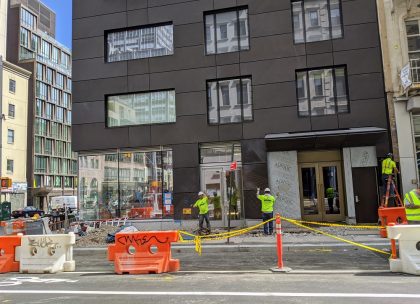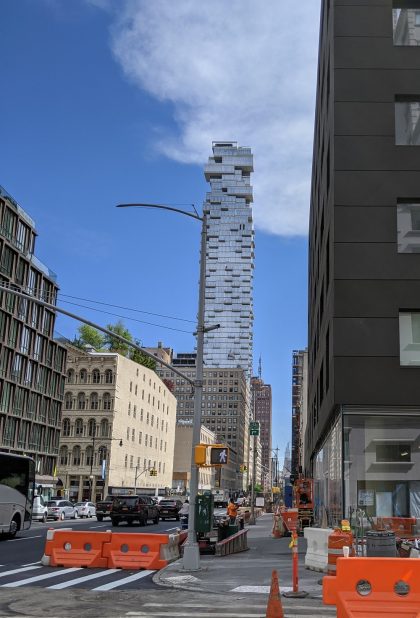Construction Update: 65 West Broadway and 30 Warren
The developers Cape Advisors have the two projects on Warren Street that have been under construction for ages: 30 Warren on the corner of Church, which is just now wrapping up; and 65 West Broadway, which has been a pit since 2017.
The foundation work at 65 West Broadway started back up again with Phase 1 reopening. I am reprinting James’ comment from the last post about it below, since it is excellent information and advice for those of us living next to construction projects.
Occupancy is ready this summer for 30 Warren. And big for the neighborhood: the sidewalks, and the sky above them, are soon to be liberated. There are plans afoot for the retail, Cape Advisors said, but nothing they were willing to reveal. (I also wondered if they had plans for the big white lotline wall on Chambers, but none so far.) Also, waiting for them to provide a new targeted finish date for 65 West Broadway.
FROM JAMES:
Once a new foundation is completed, having been poured around the footing of the rakers, then the rakers are usually removed.
These developments in and near historic districts often damage their neighbors during the construction of their foundations. Because the developer cannot “underpin” the neighbor’s foundation without consent, they often drill piles deep into the soil. Developers and GCs often use water to drill the piles and that water causes the soil next to and under the neighbors to liquefy and thereby eliminate the support of the foundation. Then the neighbor buildings tilt and drop down into the ground, if they have not already cracked from different parts of the building tilting and dropping at different rates, thus causing brittle bricks to crack because they cannot bend.
The fact that the developers usually want to dig inappropriately deep foundations in formerly marshy areas in order to have many useable basements and sub-basements (that do not count against allowable zoning floor area) means that they are more likely to do damage to their neighbors’ foundations.
If you have given the developer and the GC and the foundation contractor a written construction license to sign–which your attorney should draft and which the developer should pay for your attorney and engineering expenses and without which they cannot enter your property legally–then the developer is *strictly liable* for the damages, meaning you do not have to prove negligence by the developer or GC, but they figure on building the building first and fighting the damages bill later. Only if the Department of Buildings stops their work (and forces them to put up a raker) does the developer care.
Any neighbor and their attorney should review the 2014 Building Code “SECTION BC 3309 – PROTECTION OF ADJOINING PROPERTY.”
There are requirements for surveying your building, monitoring it during construction for damage, protecting your roof from overhead debris, making sure such protection does not prevent your rooftop ACs from working properly, etc. The developer should also agree to install permanent flashing, waterproofing, and emseal between your buildings to prevent water infiltration.
If you (the existing building) are in a landmark district, even if the new development within 90 feet is not, you should also be familiar with the more stringent requirements of Department of Buildings’ Technical Policy and Procedure Notice 10/1988 available for download here.
One should also report rat sightings, excessive noise, or other issues to 311, even if just to make a documentary record of the issues.
















Are there any photos of West Broadway site?